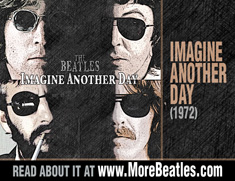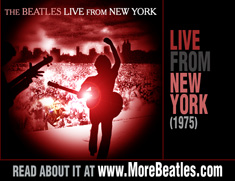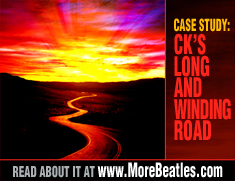
February 9, 1974 marked the tenth anniversary of the Beatles’ U.S. debut on the CBS stage of the Ed Sullivan Show. Sullivan had been gone from television for three years already, but New York Mayor Abraham Beame, who’d been in office just over a month, knew a PR opportunity when he saw one. He declared the anniversary to be “New York Loves the Beatles Day.” It was a politically tinged affair, given that the Nixon Administration was, at that very moment, attempting to deport John Lennon and Yoko Ono from the United States. The upshot was that Paul, George and Ringo all came to New York to show solidarity with John, and Beame, a Democrat, got to tweak Nixon’s nose and hang out with the Beatles.
It might have gone off beautifully except that in the attendant news coverage, Lennon made the now-famous statement that “Richard Nixon shouldn’t be in the White House, he should be in the Big House,” using the gangster slang term for prison. This proved to be just as controversial as his statement from the previous decade about the Beatles being more popular than Jesus, but with more significant impact. Henry Kissinger, Nixon’s recently appointed Secretary of State, doubled down on Lennon, and it became obvious that John and Yoko’s days in New York were numbered.
SAMPLE THE PLAYLIST!
♪ Listen to LAST WORDS on iTunes in the U.S.
♪ Listen to LAST WORDS on iTunes in Canada.
♪ Listen to LAST WORDS on iTunes in Europe.
♪ Listen to LAST WORDS on iTunes in Australia and New Zealand.
♪ Listen to LAST WORDS on iTunes in Mexico.
With the approach of spring and the American political system convulsing with Watergate, the Beatles seemed to feel that their own end couldn’t be prolonged any more than Nixon’s. Although Lennon had gone silent at his lawyer’s urgent recommendation, even the normally non-political McCartney told Time magazine, “When it’s time to go, pack your bags and get out of town.†It wasn’t clear if he was talking about the Beatles or the embattled American president.
All the Beatles had already accepted that Last Words would likely be their final album as a group, and McCartney wanted to plan their exit methodically, rather than let it play out as publicly as with the Abbey Road/Let It Be warfare that had nearly shattered the rock world almost five years earlier. The idea sounded fine in theory, but was made even more difficult by the fact that Lennon could not leave the United States for fear of never being able to get back in.
It got worse. After he took his swipe at Nixon in New York, Lennon went on a drinking binge and got banished to Los Angeles by Ono, who assigned their personal assistant May Pang to look after him. Soon, Pang became his lover.
In the final analysis, two women who really didn’t like each other much — Yoko Ono and Linda McCartney — rallied to save the Beatles long enough to record that final studio album and to stick together to stage the Live from New York concert the following year. In the aftermath, both women claimed in various interviews to have placed the original call, but the upshot was that they met for coffee in New York in March of 1974. Coffee turned into lunch, which included wine, and four hours later, there was a plan.
The solution? Last Words would not be recorded at the Abbey Road Studios but at the Los Angeles studios of the Record Plant.
Yoko was on a plane the next day to Los Angeles, where she told John in no uncertain terms it was time for him to sober up, send May Pang packing, and start writing songs like nobody’s business. “You’re the leader of the Beatles,” she said. “It’s time to act like it.” Several days later — on March 20, their wedding anniversary — they had dinner with Paul and Linda at the Palm restaurant and sealed the deal.
 In that moment of quiet diplomacy, Paul, backed by Yoko and Linda, built a bridge that John could begin to cross. George and Ringo showed up later that night, having been summoned by Yoko, to join the festivities. A night that had started out with this awkward rapprochement became a liquor-and-pot-fueled party, as the group took turns sneaking out back of the restaurant to smoke the weed Paul had brought in from London. Soon everyone realized they were beyond fighting. This was it. The End. And they knew that through all their tribulations, a funny thing had happened: The Beatles had grown closer than ever before. They had become family.
In that moment of quiet diplomacy, Paul, backed by Yoko and Linda, built a bridge that John could begin to cross. George and Ringo showed up later that night, having been summoned by Yoko, to join the festivities. A night that had started out with this awkward rapprochement became a liquor-and-pot-fueled party, as the group took turns sneaking out back of the restaurant to smoke the weed Paul had brought in from London. Soon everyone realized they were beyond fighting. This was it. The End. And they knew that through all their tribulations, a funny thing had happened: The Beatles had grown closer than ever before. They had become family.
Soon enough, all four of the mid-30s musicians had resolved to make their time together count. No walking out or walking away. They were determined to do the job like the professionals they were, and as a result, the work turned fun again. Linda was allowed to document the sessions in photographs, many of which showed the Beatles laughing together — in stark contrast to the glum images from Let It Be. Yoko participated, too, and contributed a vocal riff on McCartney’s “Helen Wheels” that fans actually came to regard as a key part of the song’s sound.
If Lennon had been ascendant in their previous effort, Imagine Another Day, then Last Words was McCartney’s turn, featuring a run of astonishingly good rockers like “Band on the Run,†“Jet†and “Junior’s Farm.†But Lennon threw some counter-punches of his own with “Mind Games,†“#9 Dream†and even the energetic “Whatever Gets You Through the Night,†a tune he wrote on a dare from Paul, who had challenged him to “write one fucking happy song once in awhile.â€
Last Words ends with McCartney’s own final statement — the bittersweet “Picasso’s Last Words,†which took both its title and its art from the death of Pablo Picasso the year before. In some ways, when it first came out, the album felt like the saddest thing ever recorded by the Beatles, and yet you still smile at the end. Just right. That Lennon let McCartney take the stage for this bow has been seen by virtually all observers as a grudging acknowledgement of his lifelong partner’s influence on him.
Yet even as the fans dried their eyes, the Beatles had one final card to play before they were done. It was a card that hadn’t been played in almost a decade.













Love this site and your alternative history of the Beatles. I’d just point out one fairly obvious factual error. The Beatles appeared for the first time on the Ed Sullivan Show on February 9, 1964 (I’m sure others have pointed this out).
Here’s an idea that perhaps could cosmically find its way into the mysterious halls of Apple: Given the amazing “mashups” that we hear now (“Helter Skelter/Whole Lotta Love”), an amazing project would be to remix some of the Beatles solo work from the early ’70s into “new” Beatles tracks and, in fact, a new Beatles album.
Brilliant! Tying McCartney’s classic in with this final album works beautifully. I just went to iTunes and bought the whole album and I’m listening to it now. It would have been one of their very, very best.